Displaying items by tag: Royal Cork Yacht Club
Cork Week Announces 'Beaufort Cup' for International Services Teams
The inaugural Beaufort Cup will take place this July hosted by the Royal Cork Yacht Club, Crosshaven, Co Cork, Ireland, as part of the highly successful Volvo Cork Week. It will be part of a series of Irish Government supported National, and International commemorations in 2016, to recognise the significant events that took place a century ago, leading to the creation of an Independent Irish Republic.
The Royal Cork Yacht Club, supported by the Irish Defence Forces is inviting services from Ireland, Europe, and further afield, to compete for the Trophy. It is hoped that Defence Force Teams from a number of countries will compete and also other services such as Police, Fire, Rescue, RNLI and Coastguard service teams.
“The Beaufort Cup invites sailing teams from their associated national services, 50% of each team must be active in the service they represent. Racing will take place over five days in a mix of challenging offshore and tactical inshore racing. Teams will get the chance to enjoy the renowned social experience of Volvo Cork Week and the winning team will also have €10,000 donated to a nominated charity of their choice while the winner will also be eligible for the ‘Boat of the Week’ prize at Volvo Cork Week 2016” says Kieran O’Connell, Chairman of Volvo Cork Week.
'It is with huge excitement that we announce the inaugural Beaufort Cup which is going to be part of Volvo Cork Week 2016. This event will attract teams from many countries and will add a unique and exciting element to the already fun packed Volvo Cork Week 2016', O'Connell say.
This event hopes to develop valuable bonds between national team members and international colleagues alike, through a competitive, but also very sociable, event. The Beaufort Cup represents a fantastic opportunity to strengthen international ties through offshore sailing and closely fought inshore racing in the natural maritime amphitheatre that is Cork Harbour.
The inaugural event, hosted by the Royal Cork Yacht Club, will truly be a historic occasion and the Irish Defence Forces are delighted to have the opportunity to support, and compete, in the Beaufort Cup. The Irish Naval Service Headquarters is located in the heart of Cork Harbour and will play a strong supportive role in the event.
The Oldest Yacht Club in the World & The Membership Issue
My Podcast about membership of sailing and yacht clubs - GETTING MEMBERS IN – INSTEAD OF KEEPING PEOPLE OUT - drew a lot of attention and comment…. It seems to have touched a topic that quite a few people felt should be openly discussed……so it is appropriate that the oldest yacht club in the world, heading for its Tercentenary – 300 years in existence – considered the issue at its annual general meeting this week.
The out-going Admiral of the RCYC – the Royal Cork Yacht Club in Crosshaven - Pat Lyons, got directly to the centrality of the issue which is a problem for many clubs in sailing, though also not a problem exclusive to maritime sport.
While the club continues to attract new members, there is an on-going erosion of its long–term membership base, he said.
So, having congratulated the new RCYC Admiral, John Roche, on his appointment, I asked him if the club was any different from others around the country, facing membership problems. He takes over leadership of the RCYC for the next two years and told me that it was no different from any others in having to address issues of membership, with an ageing scenario also. A range of initiatives is being devised as a long-term strategy.
“These will benefit the club over time, placing our focus on remaining aware of and responding to, the evolving needs of the sailing community.”
Former Cork Port Harbour Master, Pat Farnan, was elected RCYC Vice-Admiral which places him in position to succeed to the office of Admiral in two years’ time.
Kieran O’Connell, who was re-elected as Rear Admiral Keel Boats at the RCYC agm, a tribute to his commitment and ability in running cruiser racing, is also Chairman of Cork Week.
John O’Connor is the club’s new Vice Admiral for non-racing cruising boats and Stephen O’Shaughnessy was elected to the role for dinghies.
Listen to the Podcast to hear the response of the oldest yacht club in the world to the membership issue and also about its plans for the Tercentenary in 2020 which are already being worked upon and the new competitions which will form part of this year’s Cork Week.
New Admiral Elected to Royal Cork Yacht Club
The 295th Annual General Meeting of the Royal Cork Yacht Club was held last night at its Crosshaven clubhouse electing a new Club Admiral as part of the formalities writes Claire Bateman.
The cordial meeting enjoyed a full house with some good participation from members.
The Executive had completed a two year term of office and former Admiral Pat Lyons conducted the business of the meeting until it was time for the election of officers.
Vice Admiral, John Roche, was duly elected as the new Admiral of the Royal Cork Yacht Club. The election of the Officers of the Executive Committee followed. It was then time to elect two members to the Finance and Administration Committee. Two members to the Bar, Catering and House Committee and two members to the Consultancy and Advisory Committee.
The discussion of General Business then followed and there being no further questions Admiral Roche declared the meeting closed and invited all present to join him for refreshments.
Blue Skies for Royal Cork's Winter League
Blue Skies and bright sun were were welcome visitors for the second day of racing at the O’Leary Insurance Winter League writes Claire Bateman.
A sizeable fleet of twenty boats arrived on the start line this morning ready and eager for an enjoyable day of racing having had two days already blown out by the extreme weather conditions.
Race Officers Clem and Wendy McElligott in Adrielle set up a line using the Cage as the pin end and as it was a mainly northerly breeze Clem had mentioned to your scribe beforehand that racing would be mainly up and down the harbour. Wendy has taken on the onerous task of chairing a results committee and as she told me herself she enjoys this type of activity so the Keelboat Committee are indeed fortunate to have this team on board and no doubt the hard worked Rear Admiral Keelbaats, Kieran O’Connell, will be very glad to have their experience and assistance in this very important area.
The fleet set of with a reaching start, some heading inshore to avoid the flood tide, while others did the opposite and stayed out in the tide hoisting spinnakers immediately before heading out the harbour for the No. 3 buoy. They then had a beat back in the harbour up to Cobh for another reach and run and finishing with a run out to No. 5 and a reach in to finish off the Cage. Beautiful though the weather looked it was still extremely cold as had been forecast and the sailors were glad to reach the warmth of the clubhouse.
On Monday night last a Members Forum had been held and the first bit of good news the Admiral had to impart was that the EPA had approved the plan for dredging of the marina area. This in fact has started at the Western end. The Executive Officers each spoke in their turn and highlighted what had been accomplished during the past year and the early plans for our tri centenary year celebrations in 2020. The forum proper was then opened to the floor and evoked some lively discussion from the small number in attendance. This was following on from a Junior Laying Up Supper on Friday night that had packed out the house. This fact led to discussion on the lack of young people participating in club activities and one statement was heard to come from the rear that each person in this room was old!!!. This was disputed in particular by some of the younger males in the attendance who informed the comment maker they were in fact younger than him and one attractive young bride of some few weeks stood up and performed a pirouette to show her agility. There was no mention of the fact that the rest of us who know we are ‘old’ still manage to turn out in all weathers to show our interest in our club and despite the fact there was a crucial soccer match on that evening the club took preference with us.
Ah well, we all have our views, and one thing for sure is that each member of the club both young and old will be putting their best foot forward to have an almighty event in 2020 that the Royal Cork Yacht Club will long be remembered for.
New 'IRC European Championships' To Be Staged At Cork Week
The first ever IRC European Championship will take place during Volvo Cork Week, 10-15th July 2016, Royal Cork Yacht Club has announced.
The new event in the RORC Calendar will be hosted by the Crosshaven club, in the sailing grounds of Cork Harbour and the Atlantic Approaches.
The first edition of the RORC IRC National Championship took place in 2000, and has done so every year since. There are now seven IRC National Championships throughout the world, but up until now, there has been no continental event.
"When the Royal Ocean Racing Club was approached by the Royal Cork Yacht Club to host the first IRC European Championship, our response was positive and immediate. We are now working together to finalise the details”, commented Michael Boyd, Commodore of the Royal Ocean Racing Club. “The IRC European Championship will be an event in itself, based on the platform of Volvo Cork Week, which is a long-established and well-organised IRC regatta. The timing of the IRC European Championship, in the middle of July, works well in relation to the RORC IRC National Championship in the Solent in June and as a precursor to the Brewin Dolphin Commodore's Cup between 23-30 July. The intention is for the IRC European Championship to be held at a different European location annually.”
"Royal Cork Yacht Club is honoured to be chosen to host the prestigious Royal Ocean Racing Club's inaugural IRC European Championships, during Volvo Cork Week 2016. This is a great honour for Irish sailing, and the fact that Ireland has been selected as the host nation for the first ever IRC European Championship, will guarantee support from IRC boats from all over Ireland as well as overseas.” commented Kieran O Connell, Chairman of Volvo Cork Week. “It is also a great reflection on the Race Management here at Volvo Cork Week, and shows the confidence that RORC have in The Royal Cork Yacht Club’s ability to manage an event of this scale. On the racing front, Volvo Cork Week 2016 will not disappoint, with plans already well underway to host a championship that will both meet and surpass the requirements of this unique world class event both on and off the water. We welcome all in advance”.
Packed Royal Cork Clubhouse for Pyewacket Trophy Presentation
There was a packed clubhouse for the Pyewacket Trophy presentation and Junior Sailing Laying Up supper and prizegiving writes Claire Bateman
The juniors were out in force for their Laying Up supper last Friday night,with over 80 young sailors and their parents celebrating the end of another exceptional season for the club's junior sailors. As usual,the highlight of the evening was the awarding of the much coveted Pyewacket Trophy donated by the late Roy Disney. Roy brought a lot of excitement and wonderful competition to the club when sailing three of his famous Pyewackets during various Cork Weeks and was intensely committed to the promotion of sailing for young sailors.
This year the coveted trophy was won by the duo of Harry Whitaker and Peter McCann and Admiral Pat Lyons was in attendance to present the trophy. Unfortunately, Harry was unable to attend and the trophy was accepted on behalf of the duo by Peter McCann.
The next pleasurable task for Admiral Lyons was the presentation of certificates to the Flippers and Cadet club members groups.
The next part of the evening was the Rear Admiral Dinghies, Celine McGrath’s tribute to Darren O’Keeffe on his stepping down from Junior Sailing administration activities and I quote her as follows:
“For the vast majority of sailors in this room, if not all of them, you will have started out one Saturday morning in April down at the dinghy centre with about 60 other youngsters and their parents all looking a bit apprehensive – for ‘Darren’s Sessions’. Darren’s sessions have become an institution in the RCYC junior dinghies and it’s the route that almost all of us took into sailing. Darren and his family have brought more sailors into the club than probably anyone else ever has. Over many years he and Louise and the boys, Ryan, Killian and Connor, have facilitated these sessions and it’s been a family affair with the boys driving RIBs, Connor in a dinghy and Darren and Louise organizing the masses of youngsters every Saturday morning throughout April and May. Darren has now aged out of his own sessions and handed the mantle over to a new generation but I think we will continue to call them Darren’s sessions for many years to come. As a token of our respect and gratitude Darren we would like to make a small presentation to you and Louise this evening and acknowledge your massive contribution to junior dinghies at the Club.”
At this stage there was a short break in the proceedings and then each of the Class Captains spoke and presented prizes to their respective fleets. The Class Captains were Dr. Andrew Crosbie, Captain of the largest fleet by far in the club, the Optimists, Gail Enright, Mixed Dinghies including RS 200s. AnnaMarie Fegan, Topper Class Captain, Michael McCann 420 Class Captain and Paul Tingle Laser Class Captain.
To complete the prize giving there was a new trophy presented which was a poignant occasion. This is a memorial trophy to the late Frank Thompson whose recent untimely passing shocked all of us. This award goes to the person or persons adjudged to have displayed the highest possible level of voluntary commitment to Junior Sailing and the first recipients of this prestigious award were AnnaMarie Fegan and her husband Denis Murphy.
On completion of the prize giving Rear Admiral Dinghies, Celine McGrath was presented with a bouquet of flowers by Anna Keal in recognition of her dedication and efforts during the year on behalf of Junior sailing.
Royal Cork Yacht Club Annual Super League Prize Giving Evening
Saturday night saw the Royal Cork Yacht Club annual Super League prize giving dinner take place and a very enjoyable evening it was too writes Claire Bateman. Admiral Pat Lyons and the Lady Admiral, Ann, together with the ever hard working Rear Admiral Keelboats, Kieran O’Connell, entertained Sponsors and invited guests.
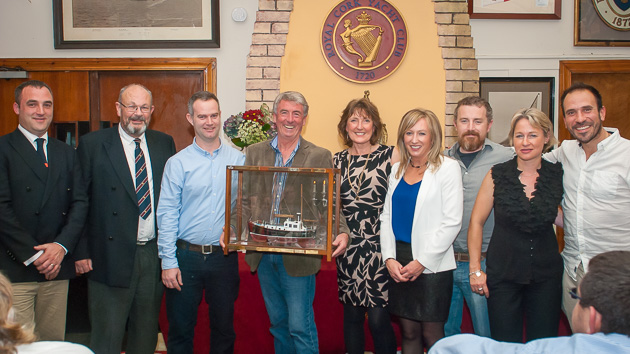
Rear Admiral Keelboats, Kieran O’Connell and Des McWilliam with the crew of Sea Hawk. Picture Robert Bateman
The events involved were the UK McWilliam May League (pcitured above), the North Sails Sunday Morning League, the Union Chandlery June League, the Coastal events, the Marshall Textiles July League, the Royal Cork September League and the September Naval Race.
Also awarded on the night was a glittering array of magnificent perpetual trophies and these combined with the awarding of the Super League trophies kept the Lady Admiral very occupied for the evening as she graciously assisted the Rear Admiral Keelboats with the presentations to the sound of cheers, applause and camera phones by the dozen appearing to float through the air.
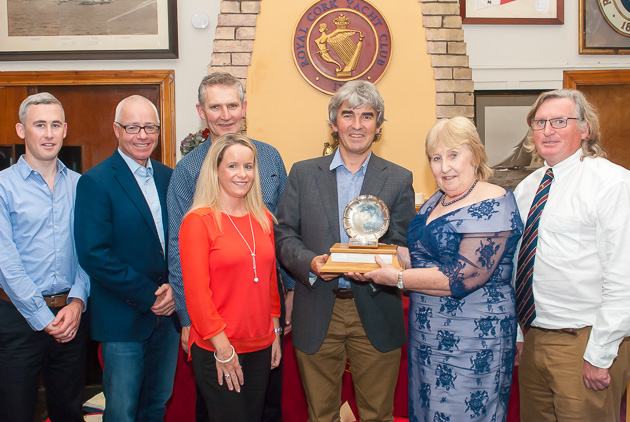
Conor Phelan and the crew of Jump Juice receiving the Boat of the Year trophy from the Lady Admiral. Picture Robert Bateman
The much coveted Boat of the Year Award was presented to a surprised but delighted Conor Phelan (above) and listed in his crew was Nigel Young. Nigel of North Sails who was accompanied to the Super League evening by his wife Fiona, is a generous sponsor to the club and this season sponsored the Sunday Morning North Sails League.
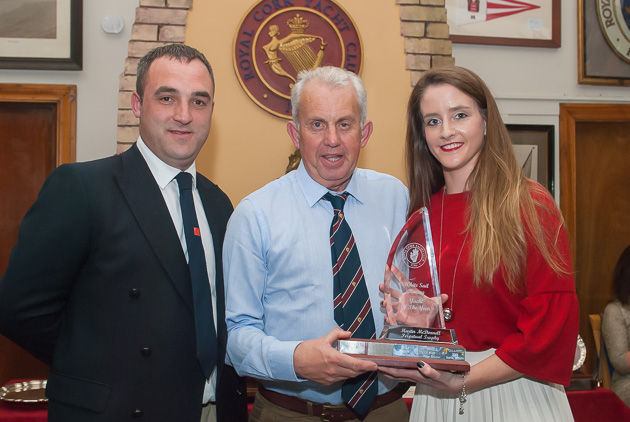
Rear Admiral Keelboats, Kieran O’Connell, John Murphy representing Scribbler 2 and Julie Anne McDonnell. Photo: Robert Bateman.
The Martin McDonnell Trophy for the Whitesail Boat of the Year was won by Tom MacSweeny's Scribbler 11 and collected by John Murphy in Tom's absence (above). Julie Anne McDonnell presented the trophy in memory of her late father and her mother, Carol, was also present at the evening.
The Club Boat of the Year was hotly contested and came down a one point difference in favour of Clem and Wendy McElligot’s Sea Hawk over Leonard Donnery’s ‘No Gnomes’. This battle was for the ‘Stack Polly’ trophy, that was a very well known boat in the Royal Cork Yacht Club and was presented on behalf of John McWilliam by his brother Des who spoke briefly on the history of the vessel.
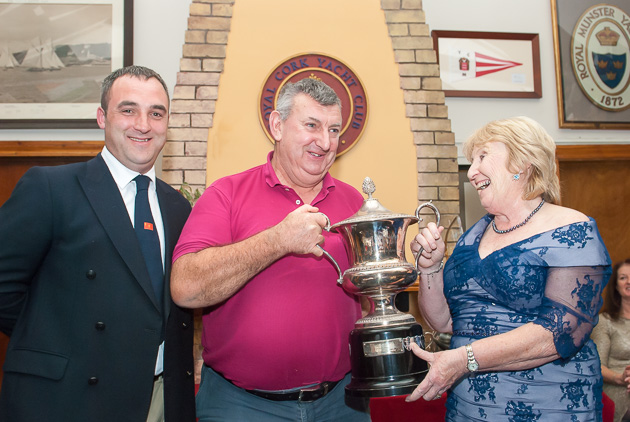
A light hearted moment as Martin Darrer accepts the Breffni McGovern Trophy from the Lady Admiral watched by Kieran O’Connell, Rear Admiral Keelboats. Picture Robert Bateman
Other trophy winners were The Phelan Trophy for IRC went to True Pennance, The Phelan Trophy for ECHO went to Tux, the H. Harling Trophy went to Heroes and Villians, the Harold Cudmore Trophy went to Bad Company, the Clytie Cup went to Sea Hawk, the Atlantic Fleet Galleon went to Thistle, the H Howard Gould Trophy went to Cosmic, the First Sloop Flotilla went to Minx 111, the Sans Souci Trophy went to Tux, the Hugh Smith Barry trophy went to Alpaca, the Bayona Trophy went to YaGottaWanna, the Breffni McGovern trophy went to True Pennance, the Smelter Valley Trophy went to Jedi, the Muckley Trophy went to YaGottaWanna, The Admiral Doyle Plate went to Loch Greine and finally, the Jim Donegan Plate went to Sea Hawk.
Thus ended the formal formal proceedings of the evening but your scribe is in no doubt the festivities continued well into the night.
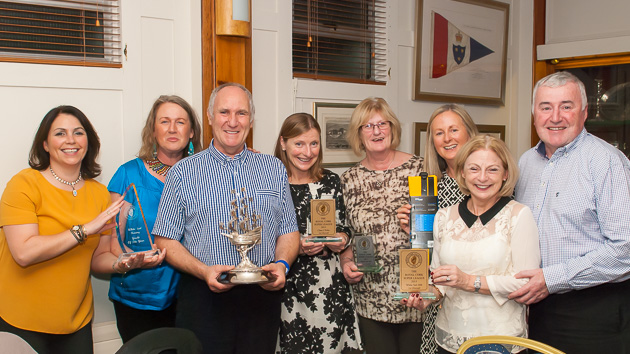
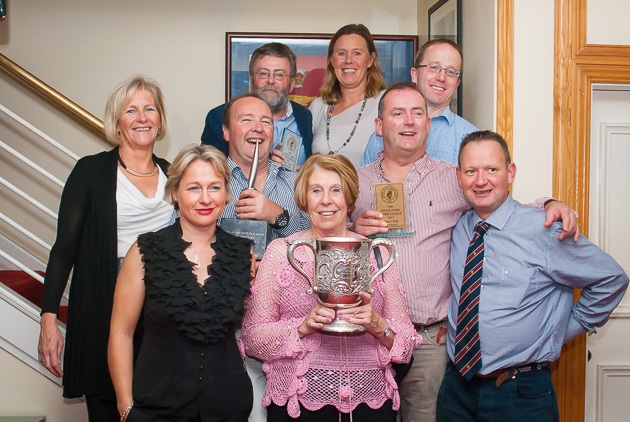
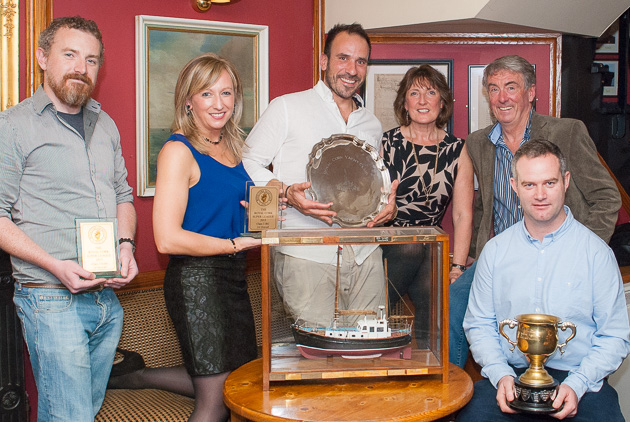
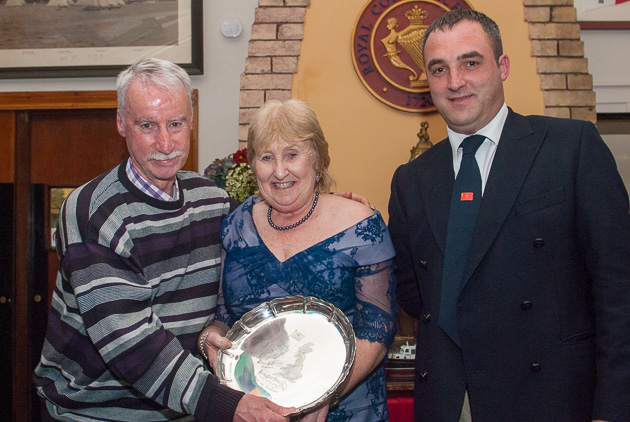
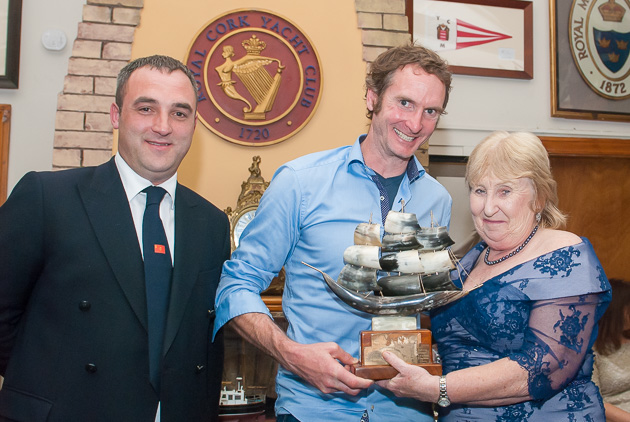

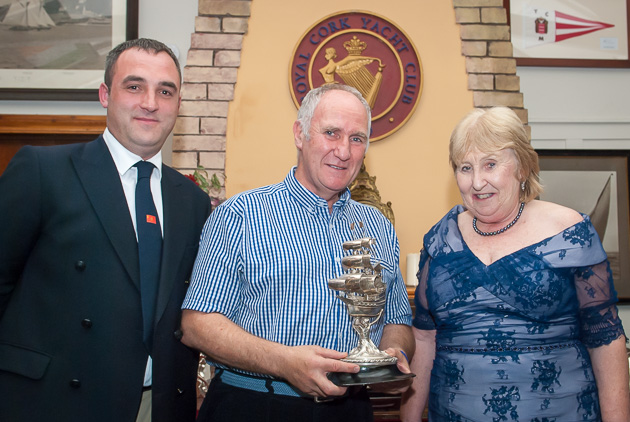

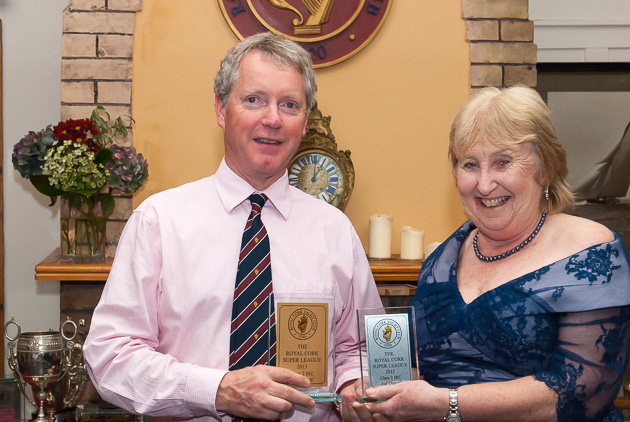

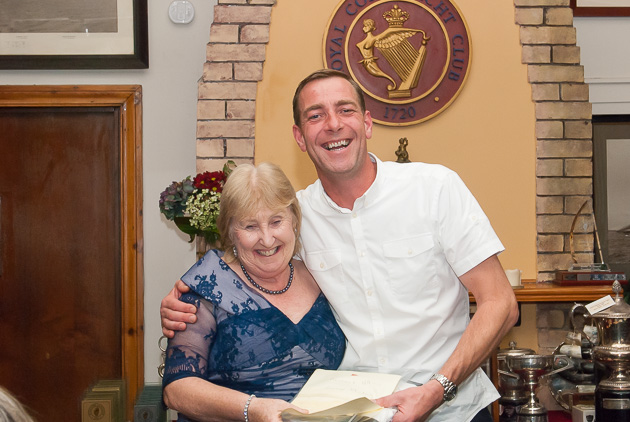
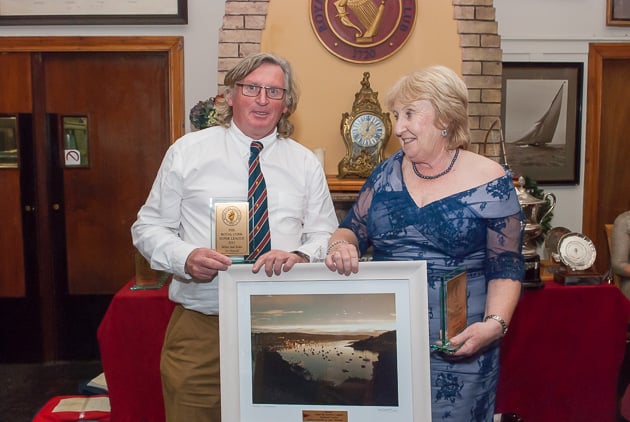
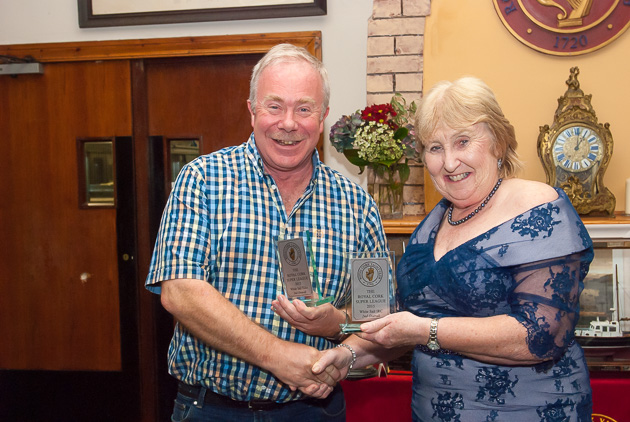
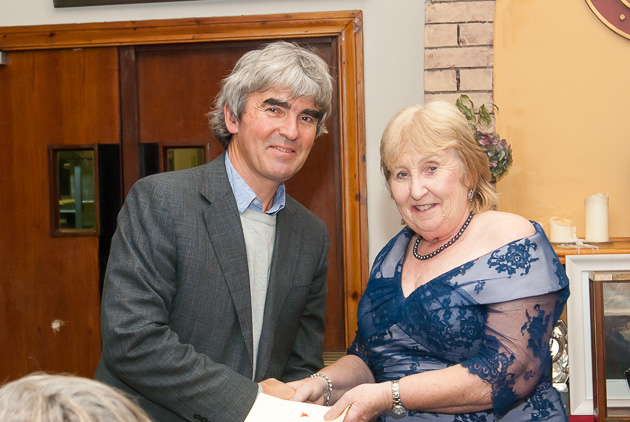

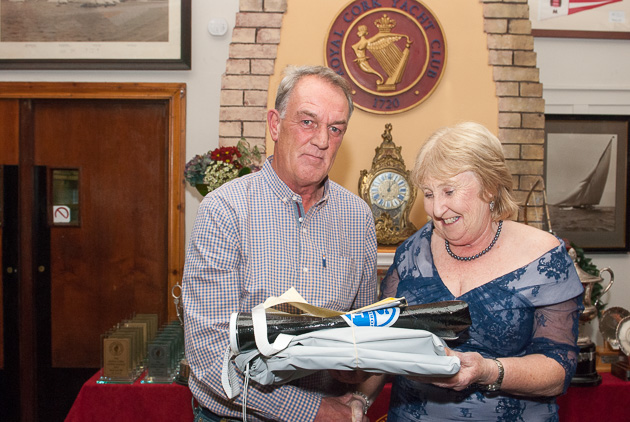

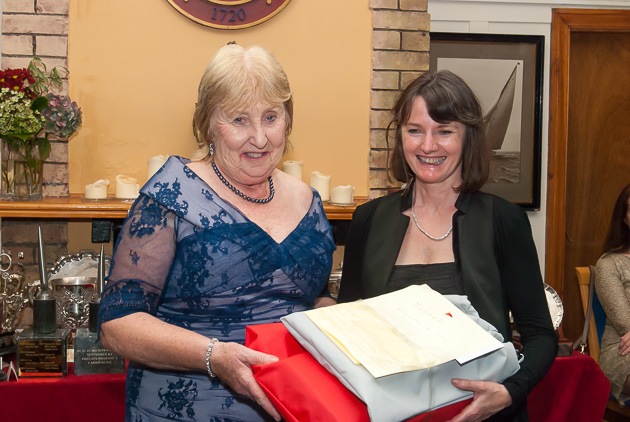
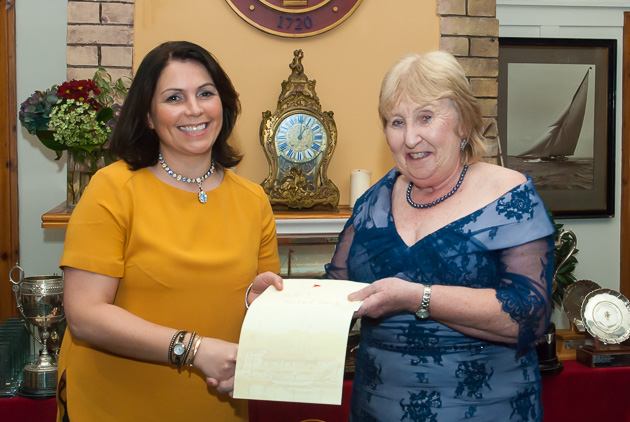
Transat Jacques Vabre Yacht Heads for Safety at Royal Cork Yacht Club
The first 24 hours of the 12th edition of the offshore Transat Jacques Vabre race, the two handed race from Le Havre in France to Itajaí, Brazil have been fast in a building breeze and at least some of the fleet is heading to Cork Harbour and, most likely, Royal Cork Yacht Club for safety.
But the Bay of Biscay and an Atlantic low pressure system will hit most of the fleet this evening and tomorrow bringing building seas and big winds with gusts over 40kts. There is no big surprise in store. The ominous system has been lurking west of Ireland for some time, but is only moving slowly SE before it fills and loses some of its intensity later on Tuesday. But the duos in all four classes have been preparing as best they can for the tough conditions, drysuits and boots are on now and may be for 48 hours or more.
Jackson Bouttell (GBR/AUS) and Gildas Mahé (FRA) on the Ker designed Concise 8 informed their Team Concise directors that they have sustained damage and are heading for Cork 120 miles to their NE.
The two co-skippers are in regular contact with Transat Jacques Vabre Race Direction and are not injured in any way and expect to reach the Irish haven by mid morning Tuesday. A full assessment of the extent of the damage will be made on arrival. They anticipate missing the worst of the imminent strong winds. Further details will be released Tuesday morning.
A number of retirements and damage reports. Fortunately no injuries reported:
* Maitre CoQ Retire
Following the damage that happened at around 2300hrs yesterday evening to a mainstay attachment, Jeremie Beyou and Philippe Legros, who were in 4th place, were forced to make their way to Roscoff, which they reached this morning at 0830hrs. The shore team and suppliers analysed the situation and attempted to replace the faulty part.
In spite of their hard work, late today they were unable to guarantee that the replacement part would be solid enough to allow the two sailors to head back out to sea without any worries. The situation was in fact all the more tense with the weather that has been forecast for the coming hours, as Maître CoQ would have likely faced some strong winds (30 - 40 knots) with a wave height of 6-7 metres
* Damage on Safran, heading to Brest
At 2020 hrs CET this evening, Morgan Lagravière, skipper of the IMOCA 60 Safran, contacted the Transat Jacques Vabre Race Directors to inform them there had been some damage aboard.
The crew (Morgan Lagravière and Nicolas Lunven) has taken the decision to head for Brest. Both skippers are fine and the conditions should allow them to reach the Breton port.
* Edmond de Rothschild Abandon in the IMOCA class
Leaders of the more westerly group of the IMOCA fleet of the Transat Jacques Vabre, Sebastien Josse and Charles Caudrelier have confirmed they have abandoned the race. They are the second of the 20 IMOCA 60s which started Sunday from Le Havre to retire. The pair made the difficult choice which was dictated by good seamanship and their aim to bring the newest Gitana back to port safely.
Sebastien Josse explained the reasons:
"Since the afternoon we had a series of incidents aboard Edmond de Rothschild. Taken individually these problems are quite minor and if we had better weather we could probably put them right. But all added up to one another and given the weather conditions we see these incidents as potentially endangering us and the boat. The weather files show more than 40kts of wind at times and seven metre seas. Charles and I consider it would not be responsible to carry on in these conditions. The boat was only launched two and a half months ago, and despite all the work which was done by the Gitana team to optimises and be ready is so short a time, these are problems associated with a recently launched boat. The decision to abandon was a very hard one but we do not want to jeopardise more than a year of hard work. The boat was designed for the Vendee Globe and that remains the major objective of the team. It is hard to retire but we must not lose sight of that as the goal."
* Prince de Bretagne Capsize, Skippers safe
The Ultime trimaran of Lionel Lemonchois and Roland Jourdain has capsized while they were 140 miles off La Coruna. The two co-skippers are safe and have taken shelter inside the trimaran. They have not requested assistance and their technical team is making every effort to organise help to rescue them and their vessel. At the time of the incident the boat was upwind in 20 to 25kts of SSW'ly wind.
Best Kept Til Last At Royal Cork's CH Marine League
Like the Last Supper the best weather was kept for the final day of the CH Marine Autumn League in Cork Harbour writes Claire Bateman. A brisk nor westerly breeze greeted the Royal Cork Yacht Club competitors. As usual, there were three race areas. Whitesail One and Two with Class Four were sailing down off the Eastern Bank and due to the nor westerly nature of the wind the courses were somewhat shorter with a lot of mark rounding .
The 1720s elected to go out an hour early to get an extra race in such was the enthusiasm of the class and they were able to get the full benefit from the direction of the wind by sailing right across the harbour where they were like greyhounds chasing around the course.
Classes One, Two and Three were in the outer harbour again today and they were given the B type course, which is the triangle course, and this gave great racing. R0 Peter Crowley decided that they would not finish in at the grassy today because it was felt the wind could be a bit flukey inside the harbour.
It was a day that one could use the old reliable description of champagne sailing with blue sea and sky, perfect breeze, and a very fitting end to the CH Marine Autumn League.
All To Play For In Final Royal Cork Autumn League Races
All racing at the Royal Cork Yacht Club yesterday had an early start to enable competitors to watch the Ireland v Argentina Match writes Claire Bateman. It was so much different passing Drakes Pool on the road to Croshaven at 9am on a rather grey day but it still looked magnificent in its stillness with wonderful reflections, a tide on the turn, the autumnal colours glorious, and the lights of the wind turbines twlnkling on and off as they rotated in the breeze.
True to the forecast there was breeze in the harbour about 10/12 knots from the north east which produced a cold nip in the early morning air. There was also an air of absolute intensity from the smallest Optimist to the largest cruiser to get to their race areas on time where the Race Officers for all the fleets were ready to go on the dot of their allotted start times.
Mention should be made here of Autumn Series Sponsor, Nick Bendon of CH Marine, a very generous sponsor. The day prizes are gift credit cards for his well known Chandlery business in Cork and Baltimore and are extremely sought after and appreciated by the winners. The main prizes will be presented at the prize giving dinner on Saturday night. CH Marine has also recently taken over the agency for the Laser brand in Ireland.
With eight races of the series now sailed several classes are wide open and it is all to play for in the final races next Saturday, October 24th.
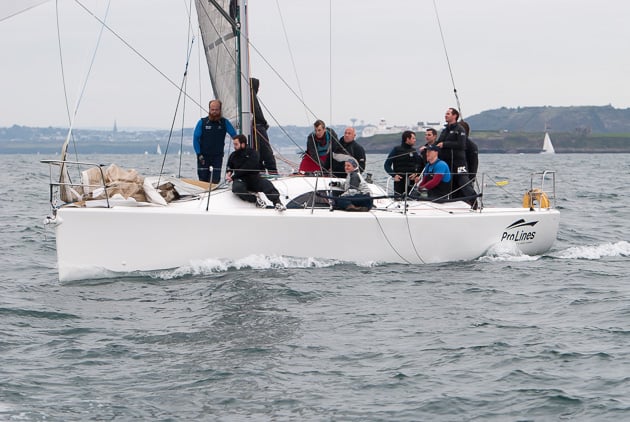
Waterford Harbours Fools Gold leads by a good margin Photo: Bob Bateman
In Class One IRC Fools Gold had two wins today and is leading by a good margin from Freya followed by Tux. In IRC Two it is very tight at the top with only two points separating the top three boats with Bad Company on 12 points, Alpaca on 13 points and No Excuse on 14 points. In IRC Three Ya Gotta Wanna and Bonanza had a first and second each today and that leaves Ya Gonna wanna on 11 points, Bonanza on 14 points and Sea Hawk is lying third on 16 points. In IRC Four our regular visitor from Kinsale, White Magic had two wins today and leads the class on 9 points with Cracker on 11 points and Seven Whistler on 22 points.
Rob Mc Connell's pro lines racing in the CH Marine Autumn league today .
Posted by Royal Cork Yacht Club on Sunday, 18 October 2015
In the 1720 Class T Bone leads on 26 points with Aquqtack on 28 points and Heros and Villians on 33 points.
In IRC WHitesail One Aisha had two wins again today and is lying on 9 points with Split Point on 12 and Wild Honey wo did not sail to day on 25 points. In IRC Whitesail Two Minx 111 lies on 9 points, with Promethus on 15 points and Fast Buck on 22 points.
Results here
Final racing will be on Saturday next October 24th





























































